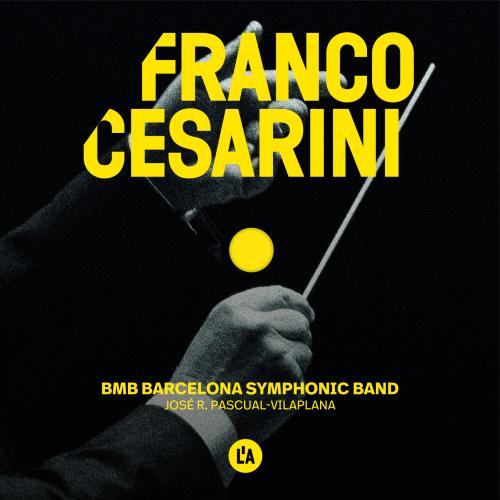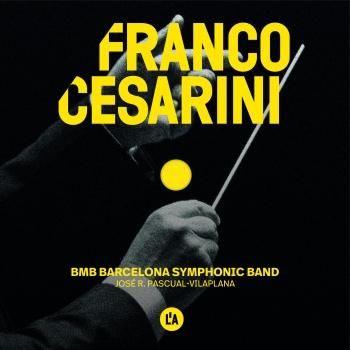
Franco Cesarini: Urban Landscapes Banda Municipal de Barcelona, José R. Pascual-Vilaplana, Franco Cesarini
Album info
Album-Release:
2023
HRA-Release:
09.01.2024
Label: L'Auditori
Genre: Classical
Subgenre: Orchestral
Artist: Banda Municipal de Barcelona, José R. Pascual-Vilaplana, Franco Cesarini
Composer: Franco Cesarini (1961)
Album including Album cover
- Franco Cesarini (b. 1961): I. Wrigley Building from Dawn to Noon:
- 1 Cesarini: I. Wrigley Building from Dawn to Noon 08:44
- II. Blue Silhouette:
- 2 Cesarini: II. Blue Silhouette 08:14
- III. Cloud Gate:
- 3 Cesarini: III. Cloud Gate 07:50
Info for Franco Cesarini: Urban Landscapes
The Barcelona Municipal Band is one of the city's oldest musical groups. Founded in 1886 by the Barcelona City Council, it has been based in the Auditorium since 2007, offering a stable concert season and developing projects in collaboration with national and international artists and orchestras. Since September 2018 it has been led by José R. Pascual-Vilaplana.
With more than 130 years of history, this wind band has remained true to its goals of motivating its creation, bringing the music of great composers to the public and offering high quality performances. In addition, it has been able to adapt to new challenges by focusing on the dissemination of the current wind band repertoire, commissioning premieres from Catalan composers or collaborating with heterogeneous artists.
As part of the new and ambitious artistic projects developed by the Auditorium of Barcelona, the Municipal Band has proposed its second “Artist Portrait”, a careful and close look at a prominent musician. This year it was the turn of the Swiss composer Franco Cesarini, a reference in the world of wind orchestras both in his homeland and abroad.
The premiere of Franco Cesarini's Symphony No. 3 “Urban Landscapes”, Op. 55, directed by the maestro himself, was of course the highlight of the concert. The composition is divided into three movements, which share, cyclically, the same thematic material, which gives the composition a strong cohesion. The first movement, The Wrigley Building from Dawn to Noon, translates into music the awakening of the city, which is slowly coming to life. The sounds of the subway and cars, the sirens of the police and the impromptu melody of a street musician can be heard. In the end, everything explodes in the bright reflection of the sun on the walls of the skyscraper. The second, Blue Silhouette, which includes slow motion and a scherzo, introduces the audience to the nightlife of the metropolis, with the background of the unmistakable rhythms of their jazz clubs. Finally, the third movement, Cloud Gate, starts with powerful fanfares to represent this musically well-known sculpture of the city center. The skyscrapers surrounding it are reflected, distorted, on the silver surface of the monument, popularly called The Bean.
This premiere has been the culmination of a program that opened with The Haunter of the Dark, Op. 17. The piece is based on a tale by the author Howard Phillips Lovecraft (1890-1937) about a deserted church, where, according to an old legend, a monster had been lying low for years. Franco Cesarini has visited it and sketches the mysterious and occult atmosphere in this composition.
The program was completed by Bulgarian Dances II, Op. 43, composed by Cesarini in 2013. Bulgarian folk music has a long tradition and numerous typical characteristics, such as particular dissonances and complex, irregular rhythms. In this composition, formed by three movements, the composer has preserved the original spirit of Bulgarian folk music.
Banda Municipal de Barcelona
José R. Pascual-Vilaplana,conductor
Franco Cesarini,conductor
Franco Cesarini
showed since childhood a strong inclination for music. At the age of seven, he joined the children’s choir of Bellinzona (Switzerland), his hometown, where his talent soon established itself: fascinated by the world of sounds, he was able to reproduce the music he heard on the piano, and this before having learned any notion of music. Later it was time to seriously learn an instrument: he took his first steps on the piano, while his passion for the flute was born soon thereafter.
At the age of 11 he attended a concert by flautist Peter-Lukas Graf, which was to be decisive for his future choices. From the very first lessons he revealed a keen interest in understanding the mechanisms that lead to musical creation, remaining enchanted by the works of the great masters. Two composers in particular attracted his attention: Claude Debussy and Béla Bartók. The study of these composers encouraged him to create something on his own. With great enthusiasm he began to devote himself to composition.
At the age of 16, his parents enrolled him at the Giuseppe Verdi Conservatoire in Milan, in piano and flute classes. Over time his passion for the flute took over, and he was admitted into the class of Peter-Lukas Graf at Basel Conservatoire, thus realizing a dream. Intense years of training followed, which saw him simultaneously engaged in his flute studies as well as in conducting and composition studies, progressively graduating in the three subjects.
Franco Cesarini found in his composition teacher, Robert Suter, a demanding personality who knew how to channel his predisposition, integrating it with the necessary writing discipline. His conducting teacher, Felix Hauswirth, introduced him to the fascinating world of wind music. During his studies he won the National Music Performance Competition and, with his Kriegslieder, he won the composition prize “European Year of Music 1985” in addition to winning, for three years in a row, the scholarship of the Ernst Göhner-Migros Foundation. ...
José R. Pascual-Vilaplana
Born on 30th April 1971 in Muro (Alicante) where he began his musical studies with the euphonium and piano in the Unión Musical de Muro, his teachers being Salvador Martínez and Mª Angeles Palacios. Later he continued his professional studies at the Municipal Conservatory of Alcoi and at the Higher Conservatory of Valencia. He studied Band Conducting with the Dutch maestro Jan COBER ("Brabants Conservatorium" in Tilburg) and with the North American conductor Eugene CORPORON (University of North Texas). He studied conducting in Vienna with Karl ÖSTERREICHER, Yuji YUHASA and Hans Graf. He has broadened his knowledge of conducting in various courses with professors such as James Croft, José Collado, Gerardo Pérez Busquier, Norman Milanés and George Pehlivanian. He studied Harmony and Composition with Rafael Alcaraz and Javier Darias.
He has attended Music Pedagogy Courses with the teachers Diego Ramón Lluch, Ana Lucía Frega and Maravillas Díaz at the Escola Comarcal de Música de la Vall d'Albaida.
Since 1988 he has studied band conducting with the Dutch maestro Jan COBER, taking several advanced courses in band conducting with Eugene CORPORON (University of North Texas). In 1993 he was selected for the speciality of Orchestra Conducting at the "Wiener Musikseminar" in Vienna, studying with Karl ÖSTERREICHER and Yuji YUHASA. In 1994 he attended James CROFT's conducting classes in Chicago at the 47th Mid West Band and Orchestra Clinic. Mid West Band and Orchestra Clinic".
In 1995 he obtained the Conducting Diploma of the "Wiener Meisterkurse für Musik" at the Musikhochschule Wien with Hans GRAF. He has broadened his knowledge of conducting in various courses with professors such as José Collado, Gerardo Pérez Busquier, Norman Milanés and Georges Pehlivanian.
This album contains no booklet.










